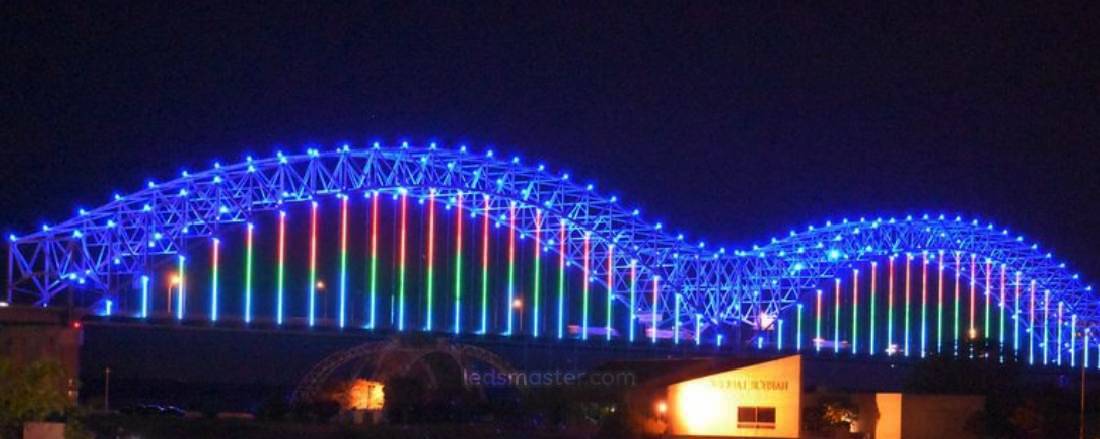Imagine a bridge that not only connects two shores but also harnesses the power of the sun to light the way—welcome to solar bridge lighting! This innovative solution offers a host of benefits over traditional grid-powered systems. By generating energy from sunlight, solar lighting eliminates the need for external electricity sources, making it perfect for remote areas where access to the grid is limited.
Get your complimentary lighting design today
Bridges are more than just functional structures; they are architectural marvels that connect communities and enhance transportation networks. Solar bridge lighting has emerged as a sustainable and efficient solution to illuminate bridges, using renewable energy sources to reduce power consumption and operational costs. Solar technology combined with modern lighting systems offers a range of benefits that make it an attractive option for bridge lighting.
Table of Contents
ToggleSolar bridge lighting offers numerous advantages over traditional grid-powered systems. First, solar lighting systems generate power directly from the sun, reducing the need for external electricity sources. By utilizing solar energy, bridges can maintain continuous lighting even in remote areas where grid access may be limited or expensive to install. The ability to harness renewable energy also helps minimize the overall environmental impact of lighting operations.

Another advantage is the reduction in energy costs. Solar lighting systems operate independently of the grid, which eliminates ongoing electricity bills. Once installed, the operating expenses are significantly lower, making solar lighting a cost-effective choice over the long term. Additionally, solar lighting systems require minimal maintenance. Modern components such as solar panels and batteries are designed to withstand harsh environmental conditions, and the use of energy-efficient LED lights ensures long-lasting performance.
Solar lighting systems also contribute to the reduction of greenhouse gas emissions, aligning with global efforts to adopt cleaner, greener energy sources. Traditional lighting methods rely on fossil fuels for electricity generation, which can lead to air pollution and a higher carbon footprint. Solar bridge lighting, on the other hand, is powered by a renewable resource, supporting eco-friendly initiatives while promoting sustainable urban development.
Enhanced safety and security are additional benefits of solar bridge lighting. Well-lit bridges reduce the risk of accidents by improving visibility for drivers and pedestrians. Consistent lighting can deter criminal activities, creating a safer environment for those using the bridge at night. Furthermore, solar-powered systems are equipped with energy storage capabilities, ensuring that lighting remains operational during power outages or in times of low sunlight.
The functionality and efficiency of solar bridge lighting systems depend on several interconnected components. These components work together to collect, store, and distribute solar energy to power the lights, ensuring reliable operation day and night.
Photovoltaic (PV) cells within the panels absorb sunlight and generate direct current (DC) electricity. The efficiency of the solar panels plays a significant role in determining how much energy can be harvested during daylight hours. Factors such as panel orientation, size, and placement on the bridge all influence energy generation.
LEDs consume significantly less power than traditional incandescent or fluorescent bulbs, making them well-suited for off-grid solar applications. LED fixtures also provide high-quality illumination, with the ability to produce bright, focused light that enhances visibility on the bridge. Additionally, LEDs are more durable and can operate effectively in various weather conditions, ensuring reliable performance over time.
Solar energy generated during the day is stored in batteries, allowing the lighting system to function at night or during cloudy periods. The capacity and type of batteries used in solar bridge lighting systems are crucial to ensuring a consistent power supply. Lithium-ion batteries are commonly used due to their high energy density and long cycle life. These batteries can store enough energy to keep the lights on for several nights, depending on the system design and energy consumption.
The power management system regulates the flow of electricity between the solar panels, batteries, and lighting fixtures. Controllers within the system ensure that batteries are charged efficiently and prevent overcharging, which could damage the battery. Some systems include sensors that automatically adjust lighting levels based on the time of day or ambient light conditions, optimizing energy usage and extending battery life.
Controllers manage the charging and discharging of batteries, ensuring optimal energy storage and utilization. Sensors, such as motion detectors or ambient light sensors, help regulate when the lights turn on or off, reducing unnecessary energy consumption during daylight hours or periods of low traffic. These features enhance the overall efficiency of the system and ensure consistent lighting performance.
Different bridges require different lighting solutions based on their location, size, and usage. Solar bridge lighting systems come in various configurations to meet the unique needs of each bridge.
| Type of Solar Bridge Lighting Solution | Description | Ideal Use Cases | Key Features |
|---|---|---|---|
| Standalone Solar Lighting Systems | Completely self-sufficient, operating independently from the electrical grid. | Remote bridges or locations with limited or unreliable grid access. | Integrated solar panels, batteries, and lighting fixtures; easy installation; energy storage capabilities for continuous illumination. |
| Hybrid Solar Lighting Systems | Combines solar power with traditional grid electricity, using solar as the primary source. | Regions with fluctuating sunlight availability, particularly during cloudy seasons. | Flexibility to switch between solar and grid power; reduces reliance on the grid; ensures continuous operation. |
| Smart Solar Lighting Systems | Incorporates IoT technology for enhanced performance and efficiency. | Urban areas where traffic patterns and lighting needs vary. | Real-time monitoring, remote control, adaptive lighting levels based on conditions, and data analytics for predictive maintenance. |
Standalone solar lighting systems are completely self-sufficient and operate independently from the electrical grid. These systems are ideal for remote bridges or locations where grid access is limited or unreliable. Standalone systems are designed with integrated solar panels, batteries, and lighting fixtures, allowing them to function entirely on solar energy. They are typically easy to install and do not require complex wiring or infrastructure, making them a practical solution for bridges in rural or off-grid areas.
Standalone systems are often equipped with energy storage capabilities, ensuring that the lights remain operational even during prolonged periods of low sunlight or inclement weather. Their independence from the grid also makes them immune to power outages, ensuring continuous illumination.
Hybrid solar lighting systems combine solar power with traditional grid electricity. These systems use solar energy as the primary power source while relying on grid electricity as a backup. Hybrid systems are especially useful in regions where sunlight availability fluctuates significantly throughout the year or during seasons with extended periods of cloud cover.
Hybrid systems offer the flexibility to switch between solar and grid power based on energy availability. When sunlight is abundant, the system prioritizes solar energy, reducing reliance on the grid and lowering electricity costs. During times of insufficient sunlight, the system seamlessly transitions to grid power, ensuring continuous operation. This combination of solar and grid power provides a reliable lighting solution while still promoting energy efficiency and sustainability.
Smart solar lighting systems incorporate advanced technology such as the Internet of Things (IoT) to enhance performance and efficiency. These systems are equipped with sensors and controllers that allow for real-time monitoring and remote control of the lighting system. Smart systems can adjust lighting levels based on traffic flow, ambient light conditions, or specific user needs, optimizing energy consumption and extending battery life.
IoT-enabled systems also provide valuable data on energy usage, system health, and performance metrics. This data can be accessed remotely, allowing for predictive maintenance and efficient management of the lighting system. Smart solar lighting systems are ideal for bridges in urban areas where traffic patterns and lighting requirements may vary throughout the day.

The design of a solar bridge lighting system involves several factors that influence the overall performance and efficiency of the system. Proper design ensures that the lighting system meets the specific needs of the bridge while optimizing energy use and minimizing maintenance requirements.
The placement of solar lighting fixtures must be carefully planned to avoid dark spots or over-illumination in certain areas. Lighting designers typically conduct detailed assessments of the bridge layout, traffic patterns, and lighting requirements to determine the optimal locations for solar lights.
Taller poles with wider spacing may be used to cover larger areas, while lower-mounted fixtures provide more focused lighting. Advanced lighting systems may use adjustable fixtures or directional LEDs to target specific areas, enhancing visibility without wasting energy.
Bridges are often exposed to extreme weather conditions, including heavy rain, snow, wind, and saltwater spray in coastal regions. Solar bridge lighting systems must be designed to withstand these environmental factors. Solar panels and LED fixtures are typically encased in weatherproof and corrosion-resistant materials to protect against moisture, dust, and other contaminants.
Battery enclosures and controllers are also designed to resist environmental damage, ensuring long-term reliability. Bridges in colder climates may require additional insulation or heating elements to prevent batteries from freezing, while those in hot climates may need ventilation to prevent overheating.
The aesthetic appearance of solar bridge lighting systems is another consideration, particularly for bridges with architectural or historical significance. Lighting fixtures should complement the overall design of the bridge without detracting from its visual appeal. In some cases, lighting designers may opt for sleek, minimalist fixtures that blend seamlessly into the bridge’s structure.
Solar panels can be strategically placed to avoid disrupting the aesthetics of the bridge. Panels may be installed on the bridge’s supports, under walkways, or integrated into existing structures to minimize their visibility. Designers often work closely with engineers and architects to ensure that the solar lighting system enhances the visual impact of the bridge while meeting all technical requirements.
Energy storage is a aspect of solar bridge lighting systems, as it ensures that the lights remain operational during periods of low sunlight. Battery capacity must be carefully calculated based on the bridge’s lighting requirements, the amount of sunlight available, and the expected duration of cloudy or rainy days.
In some cases, backup power systems such as generators or grid connections may be included as a safety measure. Backup systems provide additional reliability, particularly for bridges in regions with unpredictable weather patterns or extended periods of darkness.
The components of a solar bridge lighting system are designed to withstand prolonged exposure to the elements, ensuring durability and longevity. Solar panels, LED lights, and batteries are selected based on their ability to perform consistently over many years.
By harnessing solar energy, these systems not only reduce dependence on grid power but also lower operational costs and minimize environmental impact. Their independence from traditional energy sources ensures reliable illumination, even in remote locations, while modern components like LED lights and advanced battery storage enhance performance and longevity.
Furthermore, solar lighting contributes to reducing greenhouse gas emissions, aligning with global sustainability goals. The safety enhancements provided by well-lit bridges—improved visibility and reduced crime—make solar bridge lighting an attractive option for urban planners and engineers. With the ability to customize installations through standalone, hybrid, or smart systems, solar bridge lighting can adapt to various needs, making it a versatile and future-ready solution. As cities increasingly prioritize sustainability and innovation, solar bridge lighting stands out as a key player in promoting safer, more environmentally friendly infrastructure.